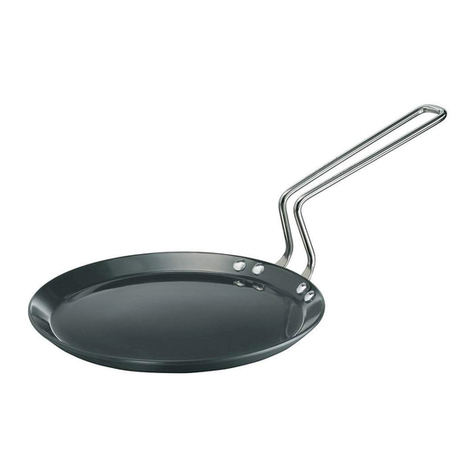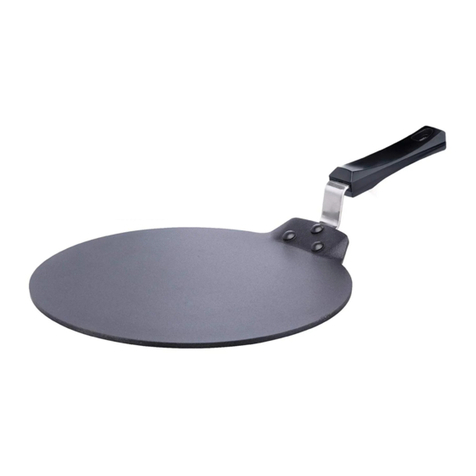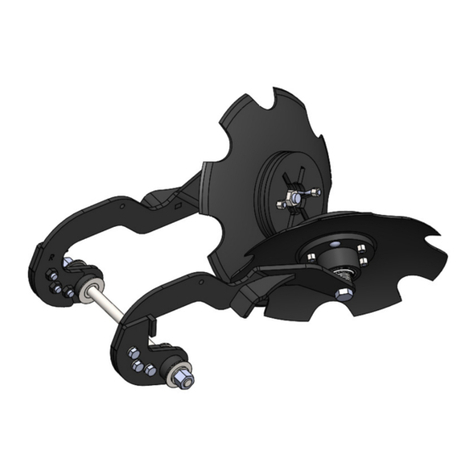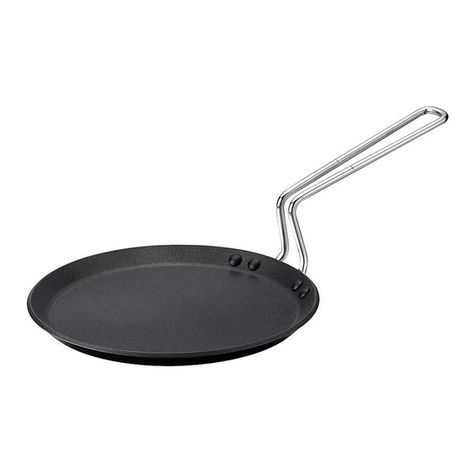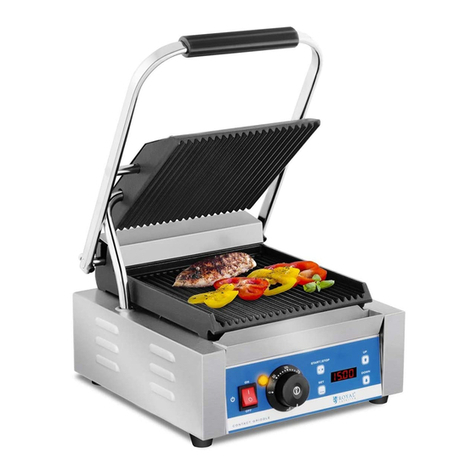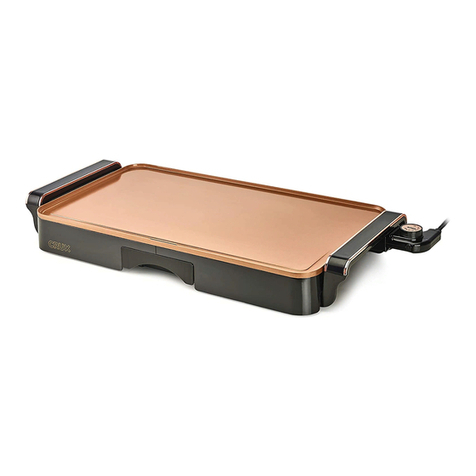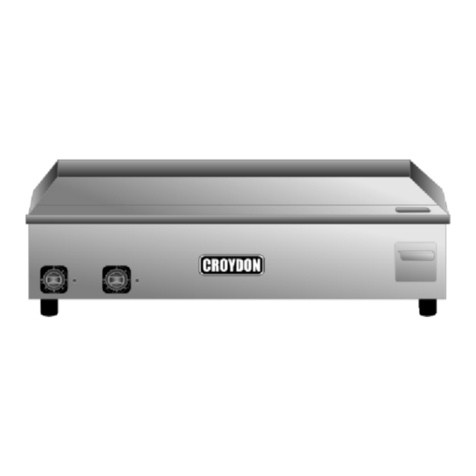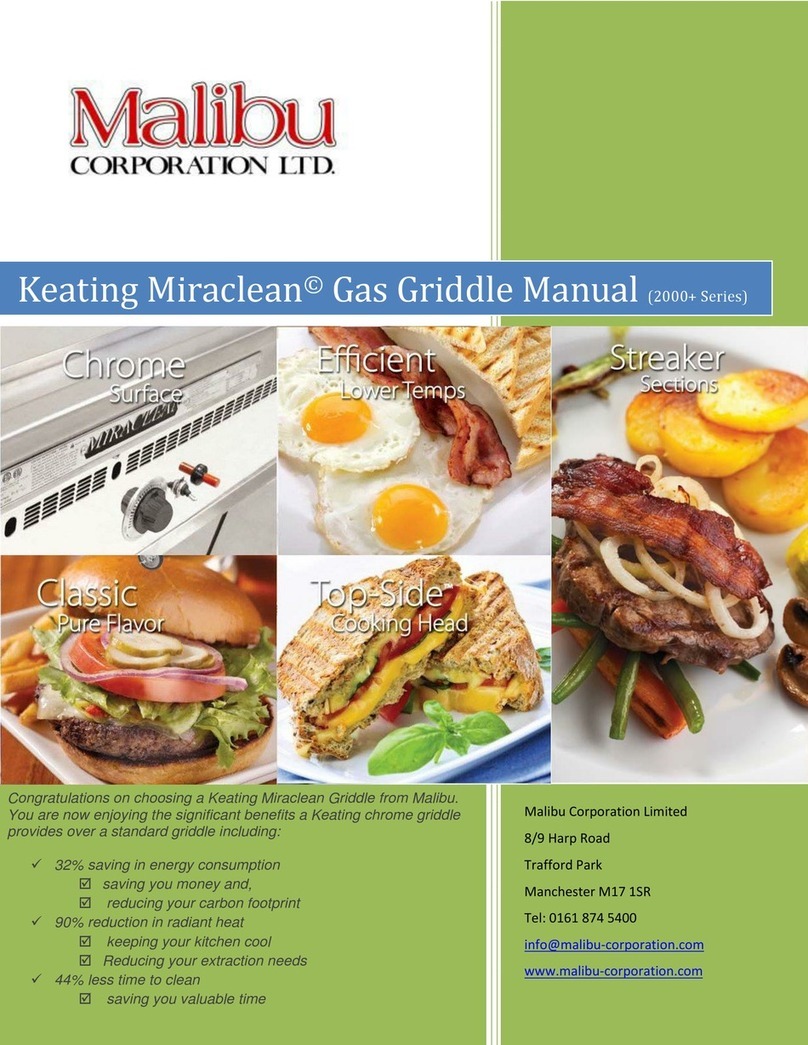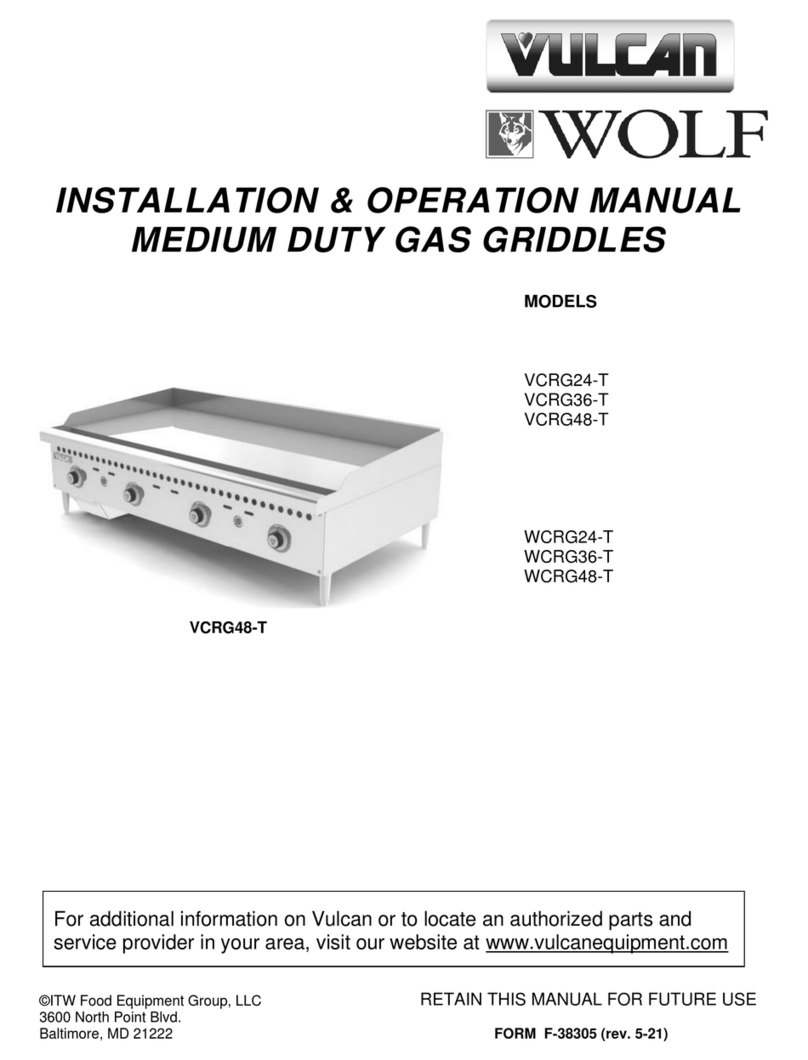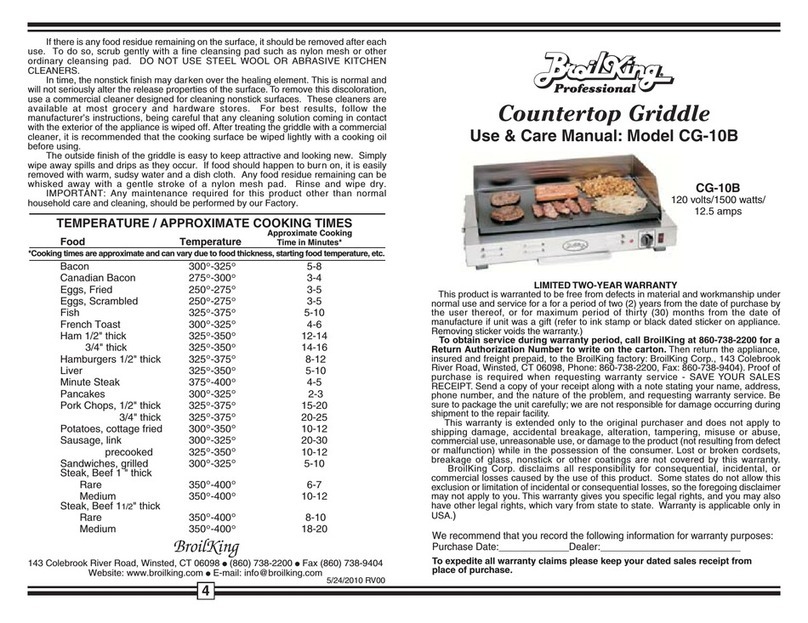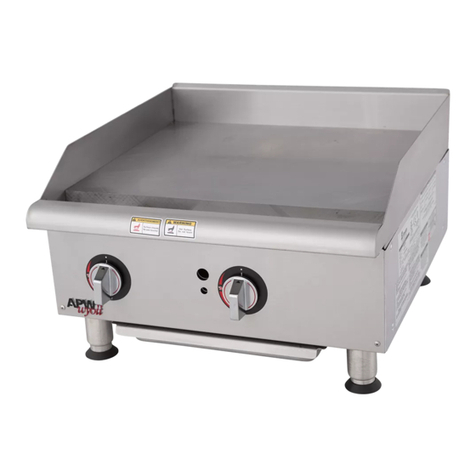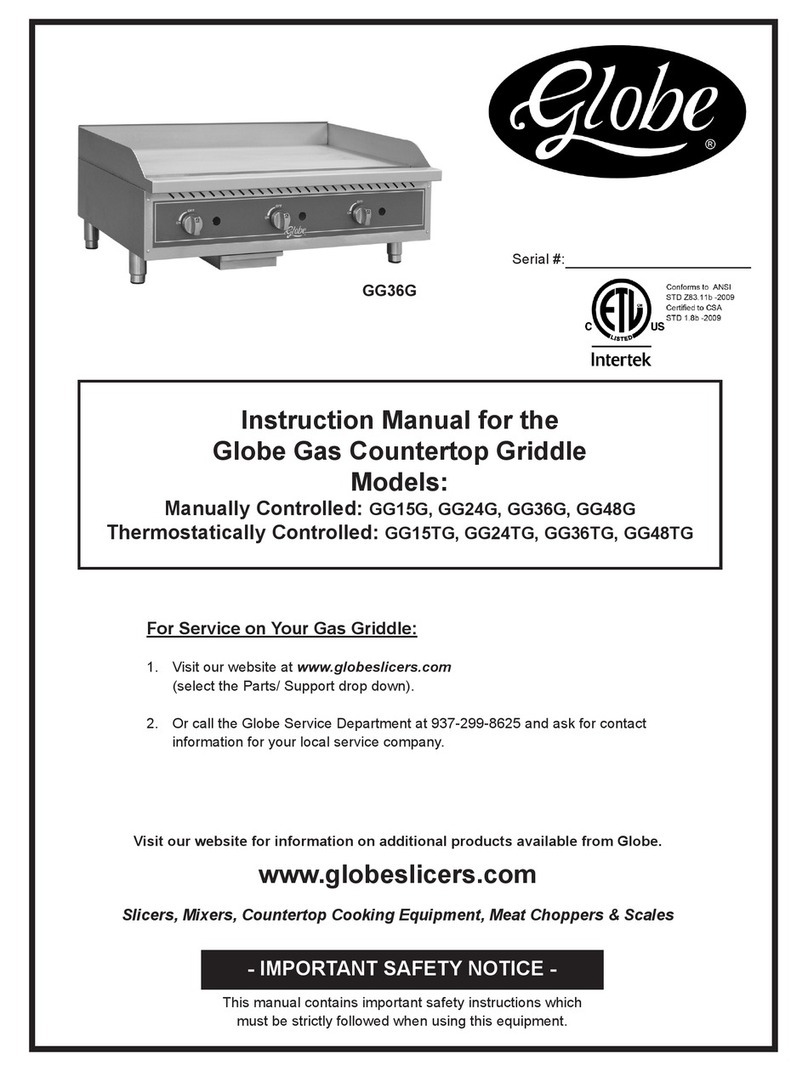Hawkins FUTURA TAVA User manual


1
IMPORTANT SAFEGUARDS
1. Always give careful attention to a hot tava, hot oil and flame/
heat. Fire is a good servant but a bad master.
2. The handle of tava should be parallel to the kitchen counter
– not sticking out.
3. Do not leave frying unattended. In case oil or butter should ever
catch fire, have a metal lid handy to cover the tava. Do not pour
water on the fire as this may spread the fire.
4. Never drop food or other objects from a height on the tava
particularly when it has hot oil or butter. Place food gently on
the tava to avoid spattering.
5. Do not put tava with plastic handle in a hot oven or under a
broiler as the plastic handle may get damaged. Tava with
stainless steel handle can be put in an oven or under a broiler
– remember to use a pot holder to hold the handle when it is hot.
6. Do not bang or hit tava with any hard or sharp object. Do not
cut or chop on tava with a metal knife or sharp object.
7. Do not put hot tava in cold water.
8. Do not wash tava in a dishwasher as it may cause the hard
anodised surface to deteriorate.
9. This tava is not nonstick – it is hard anodised. Some foods will require
some oil or water or careful control of heat to prevent sticking.
10. The tava heats quickly and retains heat well. Do not heat
excessively as this may cause burning and sticking of food.
11. Do not use tava on a coal fire or any heat source that cannot
be regulated. Use a burner to suit the size of your tava – gas
flames should not spread beyond the tava.
12. Read and follow instructions in this Manual.
IF YOU HAVE ANY QUESTIONS, COMMENTS
OR SUGGESTIONS OR IF YOU NEED ANY
HELP WITH THIS PRODUCT OR WITH ANY OF
OUR OTHER PRODUCTS, PLEASE CONTACT
THE CONSUMER SERVICE MANAGER AT:
Hawkins Cookers Limited
P O BOX 6481, MUMBAI 400 016, INDIA
TEL (91 22) 2444 0807 FAX (91 22) 2444 9152
EMAIL [email protected]
WEBSITE www.hawkinscookers.com
®

Contents
Page
Important Safeguards inside front cover
How to Contact Us inside front cover
Introduction 1
Models of the Futura Hard Anodised Tava (Griddle) 2
What Size of Roti (Indian Bread) Can You Make on a Tava? 3
How to Use 4
How to Clean 4
Easy Tips for Better Cooking 5
Saving Energy 5
How to Stuff Paratha 6
How to Cook Paratha 6
Measurements 7
Recipes
Paratha (Layered Unleavened Bread) 8
Phulka (Puffed Unleavened Bread) 9
Makai ki Roti (Corn Meal Flat Bread) 10
Paneer Tikki (Cottage Cheese Cutlets) 10
Welsh Griddle Cakes 12
Puran Poli (Sweet Stuffed Unleavened Bread) 12
Gobi Paratha (Unleavened Bread Stuffed 14
with Cauliflower)
Chana Dal Paratha (Unleavened Bread Stuffed 15
with Bengal Gram)
Pudina Paratha (Layered Unleavened Bread with Mint) 16
Alu Paratha (Unleavened Bread Stuffed with Potatoes) 18
Glossary (Meanings and Methods) 19
Translations to Hindi & English 20
Introduction
Futura Hard Anodised Cookware
Futura Hard Anodised Cookware is made from heavy gauge, pure,
virgin aluminium for fast and even heat conduction and hard anodised
to give you a tough surface that will not pit, tarnish or corrode and will
stay looking new for years. Futura Hard Anodised Cookware comes in
many useful shapes and sizes to suit your different cooking needs. All
pans are well-balanced with sturdy, stay-cool handles.
Futura Hard Anodised Tava (Griddle)
There are six models of the Futura Hard Anodised Tava (Griddle) – in
various sizes and thicknesses and two different handles. These six tava
are illustrated overleaf, page 2. The size and thickness of the tava is
stamped on the underside of the tava.
The sizes of different roti (Indian flat breads) recommended for each
size of tava are given on page 3.
Using this Manual
This Manual contains instructions and 10 recipes for all models of
the Futura Hard Anodised Tava (Griddle).
Eight of the 10 recipes are various kinds of Indian flat bread or roti.
Each of these recipes gives a choice of the sizes of roti which can be
made. Once the roti size to be made is chosen, follow the measurements
for that size roti throughout the recipe.
The two recipes which require multiple pieces of food to be cooked
in batches recommend the maximum pieces of food to be cooked at
one time.
Each recipe gives the suggested pre-heating time for each tava size;
choose the pre-heating time given for your size of tava. Other than the
pre-heating times, the heat settings in the recipes are those used for the
26 cm tava. The 22 cm and 24 cm tava may require slightly lower heat
and the 28 cm tava slightly higher heat to achieve the same cooking
times in the recipes – depending on the volume and size of the food
being cooked. For best cooking results, adjust heat so that the cooking
times are the same as those given in the recipes.
Your tava will give you years of easy, great-tasting, healthful,
economical cooking and easy clean-up if you carefully follow the
instructions in this Manual.
‘Hawkins’ and ‘Futura’ are Registered Trademarks of Hawkins Cookers Limited In India and
in various other countries throughout the world. Product design registered in India under
registration number 183242/2000. 2012 Copyright reserved in respect of logos, pictures, text, layout,
design and recipes in this Manual. All Rights Reserved. Edited and published by Neil Vasudeva on behalf
of Hawkins Cookers Limited, Maker Tower F 101, Cuffe Parade, Mumbai 400 005, India and printed in 2012
at Usha Multigraphs Pvt. Ltd., Lower Parel, Mumbai 400 013.
1

2
Models of the Futura Hard Anodised Tava (Griddle)
26 cm diameter 4.88 mm thick stainless steel handle
26 cm diameter 6.35 mm thick stainless steel handle
26 cm diameter 6.35 mm thick plastic handle
22 cm diameter 4.06 mm thick stainless steel handle
24 cm diameter 4.88 mm thick stainless steel handle
28 cm diameter 4.88 mm thick stainless steel handle

What Size of Roti (Indian Bread) Can You Make on a Tava?
22
cm 24
cm 26
cm 28
cm
14 cm
16 cm No
18 cm No No
Ta v a
Diameter
Phulka
Diameter
Phulka (page 9)
22
cm 24
cm 26
cm 28
cm
16 cm
18 cm No
20 cm No No No
Ta v a
Diameter
Paratha
Diameter
Gobi Paratha (page 14)
Chana Dal Paratha (page 15)
Alu Paratha (page 18)
22
cm 24
cm 26
cm 28
cm
16 cm
18 cm No
20 cm No No No
22 cm No No No
Ta v a
Diameter
Paratha
Diameter
Paratha (page 8)
Pudina Paratha (page 16)
22
cm 24
cm 26
cm 28
cm
14 cm
16 cm
18 cm No
20 cm No No No
Ta v a
Diameter
Roti/Poli
Diameter
Makai ki Roti (page 10)
Puran Poli (page 12)
3

How to Use
Before First Use
Remove sticker/label. Remove any adhesive with vegetable oil. Wash
in hot water with a mild soap or detergent; rinse in clear water and dry.
DO NOT WASH IN A DISHWASHER.
Suitable Heat Sources
Tava can be used on domestic gas, radiant electric or kerosene stoves.
Do not use tava on a coal fire or any source that cannot be regulated.
Use a burner to suit the size of your tava – gas flames should not spread
beyond the tava. Ensure that the stove surface in contact with the tava
is free of grease and dirt.
Regulate Heat
Futura Tava conduct heat evenly and efficiently so high heat is rarely
necessary. When pre-heating tava on high heat, do not lose track of
time so that it becomes too hot. To achieve good results, regulate the
heat used with the tava.
Prevent Sticking
Some foods will require some oil or water or careful control of heat
to prevent sticking. See Easy Tips for Better Cooking page 5, para
7 and 8.
Avoid Scratching, Damage
Do not cut or chop on tava with a knife or other sharp instrument
such as the edge of a metal spatula. Do not drop tava or bang it with
hard or sharp objects.
Do not bang tava down on pan supports. Lift tava from the pan
supports – do not drag it across the pan supports.
Do not put tava with plastic handle in a hot oven or under a broiler
as the plastic handle may get damaged. The plastic handle is liable to
break under a sharp or forceful blow.
How to Clean
Wash After Every Use
Taking care to protect your hand from the hot tava with sufficient
paper or cloth, wipe off residual oil with a paper napkin or muslin cloth
from hot tava immediately after cooking. Doing so makes cleaning very
much easier. Allow tava to cool before washing.
Always wash all surfaces of tava thoroughly after every use in
hot water with a mild soap or detergent and a dishcloth, sponge or
plastic scrubber. DO NOT WASH TAVA IN A DISHWASHER. Dishwasher
detergents may contain harsh chemicals or abrasive substances which
may damage the hard anodised finish. Let tava cool before immersing
in water. For stubborn spots, soak tava in hot water about 10 minutes
and rub with a plastic scrubber. While cleaning, keep a folded kitchen
cloth or a piece of any other soft material such as rubber or sponge
underneath the tava to avoid damaging the tava. Dry thoroughly with
a soft clean cloth. Do not store food on your tava.
Metallic marks – most often from gas stove pan supports – may
appear on the base. To remove metallic marks from base: apply a kitchen
cleanser, such as ‘Vim’, to the marks and rub with an abrasive kitchen
scrubber, such as ‘Scotch-Brite’ or fine steel wool.
Avoid “Baked-On” Food/Stains
If tava is not cleaned thoroughly, a thin layer of food or grease
may remain. When the tava is heated next, this food/grease becomes
“baked-on” and very difficult to remove. “Baked-on” food and the
stains from “baked-on” food may be impossible to remove without
damaging the tava.
If you get “baked-on” food/stains, you may try the following method
(knowing that the tava surface may get damaged): make a thick paste of
a cleaning powder such as ‘Vim’ and apply it to the “baked-on” food/stain.
Wait 5 to 10 minutes. Scour with steel wool using a circular motion. Wash.
4

Easy Tips for Better Cooking
1. Read the entire recipe before beginning to work. Assemble and
prepare all ingredients. Follow recipe step-by-step.
2. Information on weights and measures is on page 7.
3. Unless otherwise noted, in the recipes:
•All foods are to be appropriately cleaned and washed.
•Onions and fresh ginger are to be peeled.
4. For Users Outside India: In the recipes, size descriptions of
ingredients refer to food available in India. Outside India, follow the
weights rather than the size descriptions.
5. All Hindi words used in the recipes, if not translated in the recipes,
are given in Translations to Hindi & English (page 20) and/or explained
in the Glossary (Meanings and Methods) on page 19. If you come
across a word you do not know, check pages 19 and/or 20.
6. Time and heat settings in the recipes refer to the large burner of an
efficient domestic gas stove. You may have to adjust these times and
settings to suit your stove. For best cooking results, adjust the heat so
that cooking times are the same as those given in the recipes. You will
be helped in making these adjustments by the steps and indications
given in various recipes (for example, a few light brown specks should
appear on the underside of a paratha after 1 minute on medium heat).
7. Excessive heat may cause sticking and burning of food and wastes
fuel.
8. To prevent sticking of foods such as dosa, uttapam and poora
on the tava: before heating tava, rub 1/4tsp
/
1.3 ml vegetable oil using
a clean cotton cloth or paper napkin all over the tava, avoiding the rivets.
Heat tava on medium-high (a setting between medium and high) heat till
oil just begins to smoke. Reduce heat to medium. This is the point to
pour batter on tava. Heating tava to the correct temperature is critical:
if tava is heated beyond the point when oil just begins to smoke, tava
will be too hot and batter will be difficult to spread; if tava is not hot
enough (before oil just begins to smoke) batter will spread but dosa/
poora will stick. For cooking subsequent dosa/poora do not add oil on
tava before pouring batter.
9. Ghee, butter or oil can be spread on tava with a pastry brush or
spatula.
10. It may be easier to turn some foods with two spatulas rather than
one.
11. The quantities of green chillies recommended in the recipes are
calculated to produce food of moderate pungency. You may increase,
reduce or eliminate the chillies according to your taste.
12. Do not leave tava unattended while cooking as cooking times are
short and food may burn.
13. It is possible to cook with less ghee or butter than given in the recipes
or substitute oil for ghee or butter. However, this may affect the taste.
14. Eggs require controlled heat or they may become tough. Eggs
should be cooked on low to medium temperatures.
15. Eggs, batters, doughs and fillings should be at room temperature
before beginning to cook.
16. To avoid sticking when rolling out rounds of dough: slightly flatten
balls and press the balls/coils lightly in flour on both sides. Shake off
excess flour and roll out.
17. While cooking on tava, paratha and phulka leave a residue of flour
that will burn. Using a kitchen cloth, wipe off accumulated residue after
every third roti.
Saving Energy
The instructions given in this Manual for regulating heat and
producing tasty food will also optimise fuel consumption and
save energy.
5

How to Stuff Paratha
USE THESE INSTRUCTIONS AS INDICATED IN THE RECIPES.
1. Place round on palm of hand. Cup hand slightly to form a depression
in centre of round (Figure A).
2. Put amount of filling specified in recipe on round. Except potato,
lightly pat filling, spreading evenly to 1/4inch
/
6mm from edge of round
(Figure B).
3. Surround filling evenly with dough by gently opening and closing
hand slightly in a pulsating motion till some edges just meet. Pinch
together the edges which meet just enough to seal (Figure C). Pat sealed
area to get an even thickness of dough. Repeat till round is closed fully.
4. Place stuffed round on board. Flatten slightly. Stuff remaining rounds
of dough in the same way. Keep covered with a damp cloth.
5. On a floured board, roll each stuffed ball gently into a flat round as
required:
•
For 16 cm paratha:rounds 61/2inch
/
16 cm in diameter
•
For 18 cm paratha: rounds 71/4inch
/
18 cm in diameter
•
For 20 cm paratha:rounds 8 inch
/
20 cm in diameter.
Keep on a lightly floured surface, covered with a damp cloth.
How to Cook Paratha
USE THESE INSTRUCTIONS AS INDICATED IN THE RECIPES.
Paratha take about 4 minutes to cook; stuffed paratha take
about 5 minutes; makai ki roti take about 7 minutes.
1. Put round on pre-heated tava. Cook 1 minute. (Top should begin
to look dry and darken. There should be a few light brown specks on
the underside. If you can adjust the heat so that a few brown specks
appear on the underside in 1 minute, you will be cooking at the ideal
temperature. This guideline applies to the second and subsequent
rounds cooked; the first round cooked after pre-heating tava takes
about 3 minutes – keep cooking till a few light brown specks appear on
underside.) Turn over round with a broad spatula.
2. Spread 1/2tsp
/
2.5 ml ghee all over top surface of round. Turn over.
3. Spread 1/2tsp
/
2.5 ml ghee in the same way. Turn over.
4. Lightly press entire round with spatula, rotating and pressing a small
area at a time. (Pressing paratha/makai ki roti ensures even cooking. If
you notice a lighter area, press on the opposite side of that area when
you have turned over paratha/makai ki roti.) Turn over.
5. Press in the same way. Turn over.
6. Spread 1/2tsp
/
2.5 ml ghee over round. Turn over.
7. Spread 1/2tsp
/
2.5 ml ghee over round. Turn over.
8. Continue pressing and turning till paratha/makai ki roti is evenly
browned (medium-brown) on both sides. Remove.
Figure A Figure B Figure C
6

Measurements
The quantities of ingredients in the recipes are given
in two measuring systems – U.S. and metric – separated
by this mark ‘’
/
‘’. Use any one of the measurements.
Measurements of ghee in the recipes are for ghee at room temperature.
Volume
All measurements are level, not heaped.
Measurement Equivalent
1 teaspoon 5 ml
1/2tablespoon 11/2teaspoons
/
7.5 ml
1 tablespoon 3 teaspoons
/
15 ml
1/4cup 4 tablespoons
/
60 ml
1/3cup 5 tablespoons +
1 teaspoon
/
80 ml
1/2cup 8 tablespoons
/
120 ml
3/4cup 12 tablespoons
/
180 ml
1 cup 16 tablespoons
/
240 ml
1 litre 1000 ml
Weight
Metric Equivalent
28 g (rounded off to 30 g) 1 oz
450 g 16 oz
/
1 lb
1 kg 2.2 lb
Length
Measurement Equivalent
1/4inch 6 mm
3/8inch 9 mm
1/2inch 1.3 cm
5/8inch 1.6 cm
3/4inch 1.9 cm
7/8inch 2.2 cm
1 inch 2.5 cm
Abbreviations
Abbreviation Equivalent Abbreviation Equivalent Abbreviation Equivalent
tsp teaspoon oz ounce kg kilogram
tbsp tablespoon lb pound mm millimetre
ml millilitre g gram cm centimetre
7

Paratha (Layered Unleavened Bread)
Yield
16 cm diameter paratha: 12
18 cm diameter paratha: 10
20 cm diameter paratha: 8
22 cm diameter paratha: 6
5 cups
/
500 g sifted wheat flour
1 tsp
/
5 ml salt (optional)
1
3/4 cups
/
420 ml water
1/2cup + 2 tbsp
/
150 g ghee
1. Mix flour, salt and 1 cup
/
240 ml water. Add enough of remaining
water (3/4cup
/
180 ml), 2 tbsp
/
30 ml at a time, mixing after each
addition, till dough forms a soft ball (stop adding water before dough
becomes wet and sticky). Knead till dough is smooth and elastic (about
2 minutes). Keep covered with a damp cloth about 30 minutes.
2. Rub hands with a little ghee. Knead dough briefly. Make the number
and size of balls as required:
•
For 16 cm paratha:12 balls about 11/2inch
/
3.8 cm in diameter
•
For 18 cm paratha:10 balls about 15/8inch
/
4.3 cm in diameter
•
For 20 cm paratha:8 balls about 13/4inch
/
4.5 cm in diameter
•
For 22 cm paratha:6 balls about 21/4inch
/
5.4 cm in diameter.
Keep covered with a damp cloth.
3. On a floured board, roll a ball of dough into a flat round (see page
5 para 16) and spread ghee all over the top surface of the round as
required:
•
For 16 cm paratha:a round 61/2inch
/
16 cm in diameter; spread
1/2tsp
/
2.5 ml ghee
•
For 18 cm paratha: a round 71/4inch
/
18 cm in diameter; spread
1/2tsp
/
2.5 ml ghee
•
For 20 cm paratha:a round 8 inch
/
20 cm in diameter; spread
3/4tsp
/
3.8 ml ghee
•
For 22 cm paratha:a round 83/4inch
/
22 cm in diameter; spread
3/4tsp
/
3.8 ml ghee.
4. Starting at one edge, tightly roll up round (Figure A). Each time a
turn is completed, pat the top of the rolled-up portion from the centre
outward to the edges with fingers (Figure B). With palms of both hands
roll back and forth (Figure C) till extended as required:
•
For 16 cm paratha:to 8 inch
/
20 cm long
•
For 18 cm paratha: to 9 inch
/
22.5 cm long
•
For 20 cm paratha:to 10 inch
/
25 cm long
•
For 22 cm paratha:to 11 inch
/
27.5 cm long.
Wind around one end into a flat coil (Figure D). Put free end over centre
top of coil (Figure E). Press down free end gently. Flatten coil slightly.
5. Make remaining balls into rounds and coils in the same way as given
in step 3 and step 4. Keep covered with a damp cloth.
Figure A
Figure D
Figure E
Figure C
8
Figure B

Phulka (Puffed Unleavened Bread)
Yield
14 cm diameter phulka:13
16 cm diameter phulka:10
18 cm diameter phulka:8
21/2cups
/
250 g sifted wheat flour
1/2tsp
/
2.5 ml salt (optional)
3/4cup + 2 tbsp
/
210 ml water
1. Mix flour, salt and 1/2cup
/
120 ml water. Add enough of remaining
water (1/4cup + 2 tbsp
/
90 ml), 2 tbsp
/
30 ml at a time, mixing after
each addition, till dough forms a soft ball (stop adding water before
dough becomes wet and sticky). Knead till dough is smooth and elastic
(about 2 minutes). Keep covered with a damp cloth about 30 minutes.
2. With oiled hands, knead dough briefly. Make the number and size
of balls as required:
•
For 14 cm phulka:13 balls about 11/4inch
/
3 cm in diameter
•
For 16 cm phulka:10 balls about 11/2inch
/
3.8 cm in diameter
•
For 18 cm phulka:8 balls about 15/8inch
/
4 cm in diameter.
Keep covered with a damp cloth.
3. On a floured board, roll each ball of dough into a flat round (see
page 5 para 16) as required:
•
For 14 cm phulka:rounds 51/2inch
/
14 cm in diameter
•
For 16 cm phulka:rounds 61/2inch
/
16 cm in diameter
•
For 18 cm phulka:rounds 71/4inch
/
18 cm in diameter.
Keep on a lightly floured surface, covered with a damp cloth.
4. Heat tava on medium heat as follows:
•
For the 22 cm tava: 11/2minutes
•
For the 24 cm tava: 21/2minutes
•
For the 26 cm tava: 3 minutes
•
For the 28 cm tava: 3 minutes.
5. Put round on tava. Cook till small blisters appear on surface and very
few light brown specks appear on underside (about 15-20 seconds;
the first phulka takes about 2 minutes). Turn over. Cook till brown
specks appear on underside (about 50 seconds). Turn over. If you
are experienced with the technique, you may puff up phulka directly
on the flame. Otherwise, with a folded kitchen cloth, press edges of
phulka till phulka puffs up and/or underside has brown specks (about
30-40 seconds). Remove. Cook remaining rounds in the same way.
Serve hot. •
6. On a floured board, roll each coil into a flat round as required:
•
For 16 cm paratha:rounds 61/2inch
/
16 cm in diameter
•
For 18 cm paratha: rounds 71/4inch
/
18 cm in diameter
•
For 20 cm paratha:rounds 8 inch
/
20 cm in diameter
•
For 22 cm paratha:rounds 83/4inch
/
22 cm in diameter.
Keep on a lightly floured surface, covered with a damp cloth.
7. Heat tava on medium heat as follows:
•
For the 22 cm tava: 11/2minutes
•
For the 24 cm tava: 21/2minutes
•
For the 26 cm tava: 3 minutes
•
For the 28 cm tava: 3 minutes.
8. Put round on tava. Cook as explained on page 6 except, for the
following paratha sizes, each time spread ghee as required (instead of
1/2tsp
/
2.5 ml ghee):
•
For 20 cm paratha:spread 3/4tsp
/
3.8 ml ghee
•
For 22 cm paratha: spread 1 tsp
/
5 ml ghee.
9. Remove paratha from tava. With paper napkins or cloth protecting
both hands, cup hands around paratha and quickly bring together
(crushing paratha) and release. Rotate paratha 90 degrees. Repeat
crushing. Cook remaining rounds in the same way. Serve hot. •
9

Makai ki Roti (Corn Meal Flat Bread)
Yield
14 cm diameter roti:12
16 cm diameter roti:9
18 cm diameter roti:7
20 cm diameter roti:6
4 cups
/
400 g corn meal
21/4cups
/
540 ml water
1/2cup + 1/4tsp
/
120 g ghee
1. Start this step only when ready to cook. Mix corn meal and
11/2cups
/
360 ml water. Add enough of remaining water (3/4cup
/
180 ml), 2 tbsp
/
30 ml at a time, mixing after each addition, till dough
forms a soft ball. Make the number and size of balls as required:
•For 14 cm roti:12 balls about 13/4inch
/
4.5 cm in diameter
•For 16 cm roti:9 balls about 2 inch
/
5 cm in diameter
•For 18 cm roti:7 balls about 21/4inch
/
5.5 cm in diameter
•For 20 cm roti:6 balls about 21/2inch
/
6 cm in diameter.
Keep covered with a damp cloth.
2. On a well floured board, roll a ball of dough lightly. Dust rolling pin
from time to time to avoid sticking. Seal cracks by pinching edges and
continue rolling into a flat round as required:
•For 14 cm roti:around 51/2inch
/
14 cm in diameter
•For 16 cm roti:around 61/2inch
/
16 cm in diameter
•For 18 cm roti:around 71/4inch
/
18 cm in diameter
•For 20 cm roti:around 8 inch
/
20 cm in diameter.
3. Heat tava on medium heat as follows:
•For the 22 cm tava: 11/2minutes
•For the 24 cm tava: 21/2minutes
•For the 26 cm tava: 3 minutes
•For the 28 cm tava: 3 minutes.
Spread 1/4tsp
/
1.3 ml ghee on tava all over the area where the roti round
will be placed.
4. Put one hand over round and tip board till round drops onto open
palm. (If round sticks to the board, ease round using broad spatula and
tip board in the same way.)
5. Put round on tava. Cook till underside has golden brown patches (about
2 minutes; the first roti takes about 3 minutes). Turn over with a broad
spatula. Cook 2 minutes. Turn over. Continue cooking, following steps
2 to 8 of How to Cook Paratha on page 6 except, for the following roti
sizes, each time spread ghee as required (instead of 1/2tsp
/
2.5 ml ghee):
•For 18 cm roti:spread 3/4tsp
/
3.5 ml ghee
•For 20 cm roti:spread 1 tsp
/
5 ml ghee.
6. Roll out and cook remaining balls in the same way except do
not spread ghee on tava. Roll out each ball shortly before cooking
(while another round is on tava). Serve hot, accompanied with hot
sarson ka saag. •
10
Paneer Tikki (Cottage Cheese Cutlets)
Yield: 20 tikki
91/2cups
/
2.3 litres whole milk
3 tbsp + 1 tsp
/
50 ml lemon juice
2 slices bread
(each 31/4inch x 31/4inch x 3/8inch
/
8 cm x 8 cm x 1 cm)
1 cup
/
240 ml water
2 tbsp
/
30 ml cornflour
1 small (21/2oz
/
75 g) onion finely chopped
1/4cup
/
60 ml coriander leaves chopped
2 green chillies finely chopped
1
1/2tsp
/
7.5 ml salt
1/4tsp
/
1.3 ml pepper
1 tbsp + 2 tsp
/
25 ml vegetable oil

1. To make soft paneer:
a. Place a strainer over a bowl large enough to hold the milk. Line
strainer with a muslin cloth large enough to hold the curds and
then be tied by winding one corner around the others and
knotting. Keep aside.
b. Pour milk into a pan and bring to boil on high heat, stirring
occasionally to prevent skin from forming on top. Reduce heat
to medium. Add lemon juice. Stir till milk curdles (curds separate
from whey). Cook till whey has a yellow tint and has turned
from cloudy to clear (about 2 minutes), stirring and scraping the
sides and base of pan. Remove pan from heat.
c. Stir curdled milk and pour into muslin-lined strainer over the
bowl (kept aside in step 1.a). Allow to strain till whey is drained
into bowl.
d. Gather up corners of muslin and tie a knot above curds to make
a bag. Place bag on a thali, plate or board with knot on top and
press gently for a few seconds on knot to level curds. Tilt thali
slightly to drain and leave 20 minutes. Untie bag and remove
paneer. Weigh 14 oz
/
400 g paneer to make tikki. Gently
crumble paneer.
2. Immerse each bread slice in water for 15 seconds. Squeeze out and
discard water. Break bread into tiny pieces.
3. Mix gently with fingertips paneer, bread and all other ingredients
except oil. Make 20 slightly rounded patties about 2 inch
/
5 cm in
diameter, 1/2 inch
/
1.3 cm thick.
4. Spread oil on tava all over the area where the patties will be placed
as required:
•
For the 22 cm tava: 1 tsp
/
5 ml oil
•
For the 24 cm tava: 1 tsp
/
5 ml oil
•
For the 26 cm tava: 11/4tsp
/
6.3 ml oil
•
For the 28 cm tava: 11/2tsp
/
7.5 ml oil.
11
5. Place tava on medium heat as follows:
•
For the 22 cm tava: 1 minute
•
For the 24 cm tava: 1 minute
•
For the 26 cm tava: 2 minutes
•
For the 28 cm tava: 2 minutes.
Reduce heat to low.
6. Add the number of patties as required:
•
For the 22 cm tava: 4 patties
•
For the 24 cm tava: 4 patties
•
For the 26 cm tava: 5 patties
•
For the 28 cm tava: 7 patties.
Fry on both sides till golden brown (about 3 minutes on each side).
Remove.
7. Fry remaining patties in the same way as in step 4 and step 6. Serve
hot, accompanied with chutney or tomato ketchup. •

Welsh Griddle Cakes
Yield: 15 cakes
13/4cups
/
200 g refined flour
2 tsp
/
10 ml baking powder
1/4tsp
/
1.3 ml salt
1/4tsp
/
1.3 ml nutmeg powdered (optional)
1/3cup + 11/2tbsp
/
100 g cold butter cut into 1/2 inch
/
1.3 cm cubes and refrigerated till use
3/4cup
/
100 g powdered sugar
1/3cup
/
50 g raisins
1 egg beaten
1/2to 2 tsp
/
2.5 ml to 10 ml milk
1. Sift together flour, baking powder, salt and nutmeg, three times.
Place in large bowl.
2. Add cold butter into bowl. Take a cube of butter and a small portion
of flour mixture between fingertips and thumb of each hand. Raise
hands about 8 inch
/
20 cm from base of bowl. Rub butter and flour
mixture between fingers and thumbs; let mixture fall into bowl. Repeat
till all butter is rubbed in and mixture resembles fine bread crumbs. Add
sugar and raisins. Mix with a fork. Add egg. Mix with fork. Add and
mix enough milk, 1/2tsp
/
2.5 ml at a time, till mixture can be patted to
form a ball. Do not knead.
3. On a floured surface, roll out dough evenly to about 1/4inch
/
6 mm thick. Cut into rounds with pastry cutter or inverted bowl or glass
23/4inch
/
7 cm in diameter. Use a blunt knife/spatula to lift rounds and
place on a floured surface.
4. Gather trimmings and form a ball. Repeat step 3 till all dough is
cut into rounds (about 15).
5. Heat tava on medium heat as follows:
•
For the 22 cm tava: 11/2minutes
•
For the 24 cm tava: 21/2minutes
•
For the 26 cm tava: 3 minutes
•
For the 28 cm tava: 3 minutes.
Reduce heat to low.
6. Leaving the centre space free, quickly add the number of rounds as
required:
•
For the 22 cm tava: 4 rounds
•
For the 24 cm tava: 4 rounds
•
For the 26 cm tava: 5 rounds
•
For the 28 cm tava: 4, 5 or 6 rounds.
Cook about 5 minutes on each side (both sides should be golden brown).
Remove.
7. Cook remaining rounds as recommended in step 6, on low heat
about 3 minutes on each side. (Cooking 6 rounds on the 28 cm tava
may take longer than 3 minutes.) Make the number of rounds cooked
in each batch as equal as possible. Serve hot or at room temperature
accompanied with honey or jam. •
12
Puran Poli (Sweet Stuffed Unleavened Bread)
Yield
14 cm diameter poli: 18
16 cm diameter poli: 13
18 cm diameter poli: 10
20 cm diameter poli: 8
Dough
13/4cups
/
200 g sifted refined flour
1/4tsp
/
1.3 ml salt
a pinch turmeric
1/4cup + 21/2tbsp
/
97.5 ml water
1/4cup + 2 tbsp
/
90 ml vegetable oil

13
Filling
1 cup
/
200 g chana dal
12/3cups
/
400 ml water
13 oz
/
370 g gur grated
10 green cardamoms husks
removed, seeds powdered
1. To make dough: Mix flour, salt and turmeric. Add water and mix
to make a stiff dough. Add oil, 2 tbsp
/
30 ml at a time, kneading after
each addition, till dough is very soft, elastic and no longer sticky. Keep
covered 1 hour.
2. To make filling: Put chana dal and water in a Hawkins pressure
cooker. Close cooker. Bring to full pressure (first whistle) on high heat.
Reduce heat and cook 10 minutes. Remove cooker from heat. Allow
to cool naturally.
3. Open cooker. Mash dal with back of a ladle.
4. Add gur and cardamom. Cook on medium heat till mixture thickens
and leaves the sides of cooker, stirring occasionally (about 15 minutes).
Allow to cool.
5. With oiled hands, make the number and size of balls of filling as
required:
•
For 14 cm poli:18 balls about 11/4inch
/
3 cm in diameter
•
For 16 cm poli:13 balls about 13/8inch
/
3.5 cm in diameter
•
For 18 cm poli:10 balls about 15/8inch
/
4 cm in diameter
•
For 20 cm poli:8 balls about 13/4inch
/
4.5 cm in diameter.
Keep covered.
6. To make poli: Knead dough briefly. With oiled hands, make the
number and size of balls as required:
•
For 14 cm poli:18 balls about 11/4inch
/
3 cm in diameter
•
For 16 cm poli:13 balls about 13/8inch
/
3.5 cm in diameter
•
For 18 cm poli:10 balls about 15/8inch
/
4 cm in diameter
•
For 20 cm poli:8 balls about 13/4inch
/
4.5 cm in diameter.
Keep covered.
7. Rub hands with a little oil. Put a ball of dough on palm of one hand.
With fingers of other hand, pat dough outwards to form a round as
required:
•
For 14 cm poli: a round 21/2inch
/
6 cm in diameter
•
For 16 cm poli: a round 23/4inch
/
6.8 cm in diameter
•
For 18 cm poli: a round 3 inch
/
7.7 cm in diameter
•
For 20 cm poli:a round 31/2inch
/
8.5 cm in diameter.
Put a ball of filling in centre of round. Close round over filling by gently
gathering dough from sides to top, pinching to form a tiny peak. Press
peak to one side and pat dough to seal any openings. Keep assembled
ball on floured surface. Assemble and keep remaining balls in the same
way.
8. On a floured board, flatten assembled ball slightly. Roll gently into
a flat round (see page 5 para 16) as required:
•
For 14 cm poli:a round 51/2inch
/
14 cm in diameter
•
For 16 cm poli:a round 61/2inch
/
16 cm in diameter
•
For 18 cm poli:a round 71/4inch
/
18 cm in diameter
•
For 20 cm poli:a round 8 inch
/
20 cm in diameter.
Roll out remaining balls in the same way. Keep covered.
9. Heat tava on medium heat as follows:
•
For the 22 cm tava: 11/2minutes
•
For the 24 cm tava: 21/2minutes
•
For the 26 cm tava: 3 minutes
•
For the 28 cm tava: 3 minutes.
Put round on tava. Cook 1 minute (underside should have very few
faint brown specks). Turn over. Cook second side similarly 1 minute.
Remove. Cook remaining rounds in the same way. Serve hot or at room
temperature. Optional garnish: melted ghee or butter. •

14
Gobi Paratha (Unleavened Bread Stuffed with
Cauliflower)
Yield
16 cm diameter paratha:12
18 cm diameter paratha:9
20 cm diameter paratha: 8
Dough
4 cups
/
400 g sifted wheat flour
1/2tsp
/
2.5 ml salt
1 tbsp + 2 tsp
/
25 ml ghee
11/3cups + 2 tsp
/
330 ml water
Filling
3 medium (3 lb 5 oz
/
1.5 kg) cauliflowers leaves and tough
lower part of stems removed,
quartered (1 lb 11 oz
/
760 g)
1 tbsp + 2 tsp
/
25 ml salt
2 medium (7 oz
/
200 g) onions finely chopped
1
1/2tsp
/
7.5 ml cumin seeds
4 green chillies finely chopped
1/4cup
/
60 ml coriander leaves finely
chopped
Ghee for Frying
1/2cup
/
120 g
1. To make dough: Mix flour, salt, ghee and 1 cup
/
240 ml water.
Add enough of remaining water (1/4cup + 2 tbsp
/
90 ml), 2 tbsp
/
30 ml at a time, mixing after each addition, till dough forms a soft ball
(stop adding water before dough becomes wet and sticky). Knead till
dough is smooth and elastic (about 2 minutes). Keep covered with a
damp cloth about 30 minutes.
2. To make filling: Grate cauliflower. Mix cauliflower and salt. Keep
aside 15 minutes. Squeeze gently and discard water. Add remaining
ingredients. Mix.
3. Rub hands with a little ghee. Knead dough briefly. Make the number
and size of balls as required:
•For 16 cm paratha:12 balls about 11/2inch
/
3.8 cm in diameter
•For 18 cm paratha:9 balls about 15/8inch
/
4 cm in diameter
•For 20 cm paratha:8 balls about 13/4inch
/
4.3 cm in diameter.
Keep covered with a damp cloth.
4. On a floured board, roll each ball of dough into a flat round (see
page 5 para 16) as required:
•For 16 cm paratha:rounds 4 inch
/
10 cm in diameter
•For 18 cm paratha: rounds 4.5 inch
/
11 cm in diameter
•For 20 cm paratha:rounds 5 inch
/
12.5 cm in diameter.
Keep on a lightly floured surface, covered with a damp cloth.
5. To stuff paratha: Follow illustrated steps on page 6, using the
amount of filling for each round of dough as required:
•For 16 cm paratha:51/2tbsp
/
55 g filling
•For 18 cm paratha:7 tbsp
/
70 g filling
•For 20 cm paratha:81/2tbsp
/
85 g filling.
6. Heat tava on medium heat as follows:
•For the 22 cm tava: 11/2minutes
•For the 24 cm tava: 21/2minutes
•For the 26 cm tava: 3 minutes
•For the 28 cm tava: 3 minutes.
7. Put round on tava. Cook as explained on page 6 except, for a
20 cm paratha, each time spread 3/4tsp
/
3.8 ml ghee (instead of
1/2tsp
/
2.5 ml ghee). Cook remaining rounds in the same way. Serve
hot, accompanied with curd. •

15
Chana Dal Paratha (Unleavened Bread Stuffed
with Bengal Gram)
Yield
16 cm diameter paratha:12
18 cm diameter paratha:9
20 cm diameter paratha: 8
Filling
2 cups + 3 tbsp
/
525 ml water
1
1/8cups
/
225 g chana dal soaked in 2 cups
/
480 ml water for 15 minutes
and drained
1
3/4tsp
/
8.8 ml salt
1/4tsp
/
1.3 ml turmeric
1 medium (4 oz
/
115 g) onion finely chopped
1 x
1/2inch
/
1.3 cm piece fresh ginger finely chopped
(
1/6oz
/
5 g)
4 green chillies finely chopped
1/4cup
/
60 ml coriander leaves finely chopped
Dough
4 cups
/
400 g sifted wheat flour
1/2tsp
/
2.5 ml salt
1 tbsp + 2 tsp
/
25 ml ghee
11/3cups + 2 tsp
/
330 ml water
Ghee for Frying
1/2cup
/
120 g
1. To make filling: Bring water to boil in a medium pan on high
heat. Add chana dal, salt and turmeric. Stir. Bring to boil. Reduce
heat to low. Cover and cook till dal is tender but not mushy (about
35 minutes). Meanwhile, do step 2.Drain off excess water, if any.
Allow to cool. Add remaining ingredients. Mix.
2. To make dough: Mix flour, salt, ghee and 1 cup
/
240 ml water.
Add enough of remaining water (1/4cup + 2 tbsp
/
90 ml), 2 tbsp
/
30 ml at a time, mixing after each addition, till dough forms a soft ball
(stop adding water before dough becomes wet and sticky). Knead till
dough is smooth and elastic (about 2 minutes). Keep covered with a
damp cloth about 30 minutes.
3. Rub hands with a little ghee. Knead dough briefly. Make the number
and size of balls as required:
•For 16 cm paratha:12 balls about 11/2inch
/
3.8 cm in diameter
•For 18 cm paratha:9 balls about 15/8inch
/
4 cm in diameter
•For 20 cm paratha:8 balls about 13/4inch
/
4.3 cm in diameter.
Keep covered with a damp cloth.
4. On a floured board, roll each ball of dough into a flat round (see page
5 para 16) as required:
•For 16 cm paratha:rounds 4 inch
/
10 cm in diameter
•For 18 cm paratha: rounds 4.5 inch
/
11 cm in diameter
•For 20 cm paratha:rounds 5 inch
/
12.5 cm in diameter.
Keep on a lightly floured surface, covered with a damp cloth.
5. To stuff paratha: Follow illustrated steps on page 6, using the
amount of filling for each round of dough as required:
•For 16 cm paratha: 1/4cup
/
60 ml filling
•For 18 cm paratha:1/4cup + 1 tbsp
/
75 ml filling
•For 20 cm paratha:1/3cup + 1tbsp
/
95 ml filling.
6. Heat tava on medium heat as follows:
•For the 22 cm tava: 11/2minutes
•For the 24 cm tava: 21/2minutes
•For the 26 cm tava: 3 minutes
•For the 28 cm tava: 3 minutes.
7. Put round on tava. Cook as explained on page 6 except, for a
20 cm paratha, each time spread 3/4tsp
/
3.8 ml ghee (instead of
1/2tsp
/
3.8 ml ghee). Cook remaining rounds in the same way. Serve
hot, accompanied with curd. •

16
Pudina Paratha (Layered Unleavened Bread
with Mint)
Yield
16 cm diameter paratha: 12
18 cm diameter paratha: 10
20 cm diameter paratha: 8
22 cm diameter paratha: 6
41/2cups
/
450 g sifted wheat flour
51/2cups
/
85 g
mint leaves chopped
2 tsp
/
10 ml
cumin seeds
2 tsp
/
10 ml vegetable oil
11/2tsp
/
7.5 ml salt
a pinch pepper
a pinch red chilli powder
11/4cups
/
300 ml water
1/2cup + 2 tbsp
/
150 g ghee
1. Mix all ingredients except water and ghee. Add 3/4cup
/
180 ml water.
Mix. Add enough of remaining water (1/2cup
/
120 ml), 2 tbsp
/
30 ml
at a time, mixing after each addition, till dough forms a soft ball (stop
adding water before dough becomes wet and sticky). Knead till dough
is smooth and elastic (about 2 minutes). Keep covered with a damp
cloth about 30 minutes.
2. Rub hands with a little ghee. Knead dough briefly. Make the number
and size of balls as required:
•
For 16 cm paratha:12 balls about 11/2inch
/
3.8 cm in diameter
•
For 18 cm paratha:10 balls about 15/8inch
/
4.2 cm in diameter
•
For 20 cm paratha:8 balls about 13/4inch
/
4.5 cm in diameter
•
For 22 cm paratha:6 balls about 2 inch
/
5 cm in diameter.
Keep covered with a damp cloth.
3. On a floured board, roll a ball of dough into a flat round (see page
5 para 16) and spread ghee all over the top surface of the round as
required:
•
For 16 cm paratha:a round 61/2inch
/
16 cm in diameter; spread
1/2tsp
/
2.5 ml ghee
•
For 18 cm paratha: a round 71/4inch
/
18 cm in diameter; spread
1/2tsp
/
2.5 ml ghee
•
For 20 cm paratha:a round 8 inch
/
20 cm in diameter; spread
3/4tsp
/
3.8 ml ghee
•
For 22 cm paratha:a round 83/4inch
/
22 cm in diameter; spread
3/4tsp
/
3.8 ml ghee.
4. Starting at one edge, tightly roll up round (Figure A). Each time a
turn is completed, pat the top of the rolled-up portion from the centre
outward to the edges with fingers (Figure B). With palms of both hands
roll back and forth (Figure C) till extended as required:
•
For 16 cm paratha:to 8 inch
/
20 cm long
•
For 18 cm paratha: to 9 inch
/
22.5 cm long
•
For 20 cm paratha:to 10 inch
/
25 cm long
•
For 22 cm paratha:to 11 inch
/
27.5 cm long.
Wind around one end into a flat coil (Figure D). Put free end over centre
top of coil (Figure E). Press down free end gently. Flatten coil slightly.
Figure A Figure B
Figure D
Figure E
Figure C

17
5. Make remaining balls into rounds and coils in the same way as given
in step 3 and step 4. Keep covered with a damp cloth.
6. On a floured board, roll each coil into a flat round as required:
•
For 16 cm paratha:rounds 61/2inch
/
16 cm in diameter
•
For 18 cm paratha: rounds 71/4inch
/
18 cm in diameter
•
For 20 cm paratha:rounds 8 inch
/
20 cm in diameter
•
For 22 cm paratha:rounds 83/4inch
/
22 cm in diameter.
Keep on a lightly floured surface, covered with a damp cloth.
7. Heat tava on medium heat as follows:
•
For the 22 cm tava: 11/2minutes
•
For the 24 cm tava: 21/2minutes
•
For the 26 cm tava: 3 minutes
•
For the 28 cm tava: 3 minutes.
8. Put round on tava. Cook as explained on page 6 except, for the
following paratha sizes, each time spread ghee as required (instead of
1/2tsp
/
2.5 ml ghee):
•
For 20 cm paratha:spread 3/4tsp
/
3.8 ml ghee
•
For 22 cm paratha: spread 1 tsp
/
5 ml ghee.
9. Remove paratha from tava. With paper napkins or cloth protecting
both hands, cup hands around paratha and quickly bring together
(crushing paratha) and release. Rotate paratha 90 degrees. Repeat
crushing. Cook remaining rounds in the same way. Serve hot,
accompanied with curd. •

18
Alu Paratha (Unleavened Bread Stuffed with
Potatoes)
Yield
16 cm diameter paratha: 12
18 cm diameter paratha: 9
20 cm diameter paratha: 8
Filling
1 cup
/
240 ml water
6 medium (1 lb 5 oz
/
600 g) potatoes
2 medium (7 oz
/
200 g) onions finely chopped
2 green chillies finely chopped
1
1/2tbsp
/
22.5 ml coriander leaves chopped
2
1/2tsp
/
12.5 ml salt
11/2tsp
/
7.5 ml cumin seeds
1/2tsp
/
2.5 ml red chilli powder
1
1/4tsp
/
6.3 ml coriander powder
a pinch pepper
1 tbsp
/
15 ml pomegranate seeds crushed
Dough
33/4cups
/
375 g sifted wheat flour
1/2tsp
/
2.5 ml salt
1 tbsp + 2 tsp
/
25 ml ghee
11/4cups
/
300 ml water
Ghee for Frying
1/2cup
/
120 g
1. To make filling: Pour water in a Hawkins pressure cooker. Place
potatoes in cooker, preferably on a grid. Close cooker. Bring to full
pressure (first whistle) on high heat. Reduce heat and cook 10 minutes.
Meanwhile do step 5.
2. Remove cooker from heat. Release pressure by slight lifting of vent
weight.
3. Open cooker. Remove potatoes. Cool just till potatoes can be handled.
Peel and mash potatoes. Allow to cool. Add remaining ingredients. Mix.
4. Rub hands with a little ghee. Make the number and size of balls as
required:
•
For 16 cm paratha:12 balls about 11/2inch
/
3.8 cm in diameter
•
For 18 cm paratha:9 balls about 17/8inch
/
4.6 cm in diameter
•
For 20 cm paratha:8 balls about 2 inch
/
5 cm in diameter.
Keep covered.
5. To make dough: Mix flour, salt, ghee and 3/4cup
/
180 ml
water. Add enough of remaining water (1/2cup
/
120 ml), 2 tbsp
/
30 ml
at a time, mixing after each addition, till dough forms a soft ball (stop
adding water before dough becomes wet and sticky). Knead till dough
is smooth and elastic (about 2 minutes). Keep covered with a damp
cloth about 30 minutes.
6. Rub hands with a little ghee. Knead dough briefly. Make the number
and size of balls as required:
•
For 16 cm paratha:12 balls about 11/2inch
/
3.8 cm in diameter
•
For 18 cm paratha:9 balls about 15/8inch
/
4.2 cm in diameter
•
For 20 cm paratha:8 balls about 13/4inch
/
4.5 cm in diameter.
Keep covered with a damp cloth.
7. On a floured board, roll each ball of dough into a flat round (see
page 5 para 16) as required:
•
For 16 cm paratha:rounds 4 inch
/
10 cm in diameter
•
For 18 cm paratha: rounds 4.5 inch
/
11 cm in diameter
•
For 20 cm paratha:rounds 5 inch
/
12.5 cm in diameter.
Keep on a lightly floured surface, covered with a damp cloth.
8. To stuff paratha: Follow illustrated steps on page 6, using 1 ball
of filling for each round of dough.
9. Heat tava on medium heat as follows:
•
For the 22 cm tava: 11/2minutes
•
For the 24 cm tava: 21/2minutes
•
For the 26 cm tava: 3 minutes
•
For the 28 cm tava: 3 minutes.
10. Put round on tava. Cook as explained on page 6 except, for a
20 cm paratha, each time spread 3/4tsp
/
3.8 ml ghee (instead of
1/2tsp
/
2.5 ml ghee). Cook remaining rounds in the same way. Serve
hot, accompanied with curd. •
Table of contents
Other Hawkins Griddle manuals
Popular Griddle manuals by other brands

Lang
Lang LGD Installation, operation, maintenance, & troubleshooting
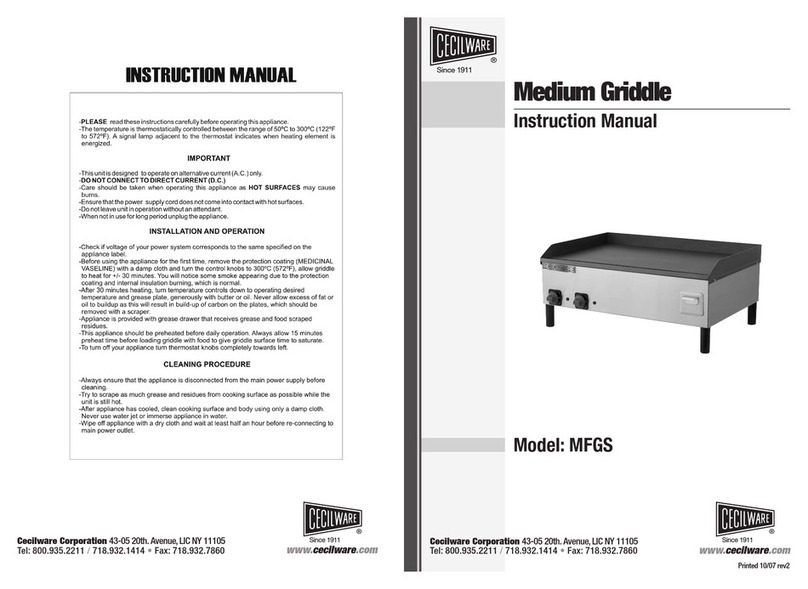
Cecilware
Cecilware MFGS instruction manual
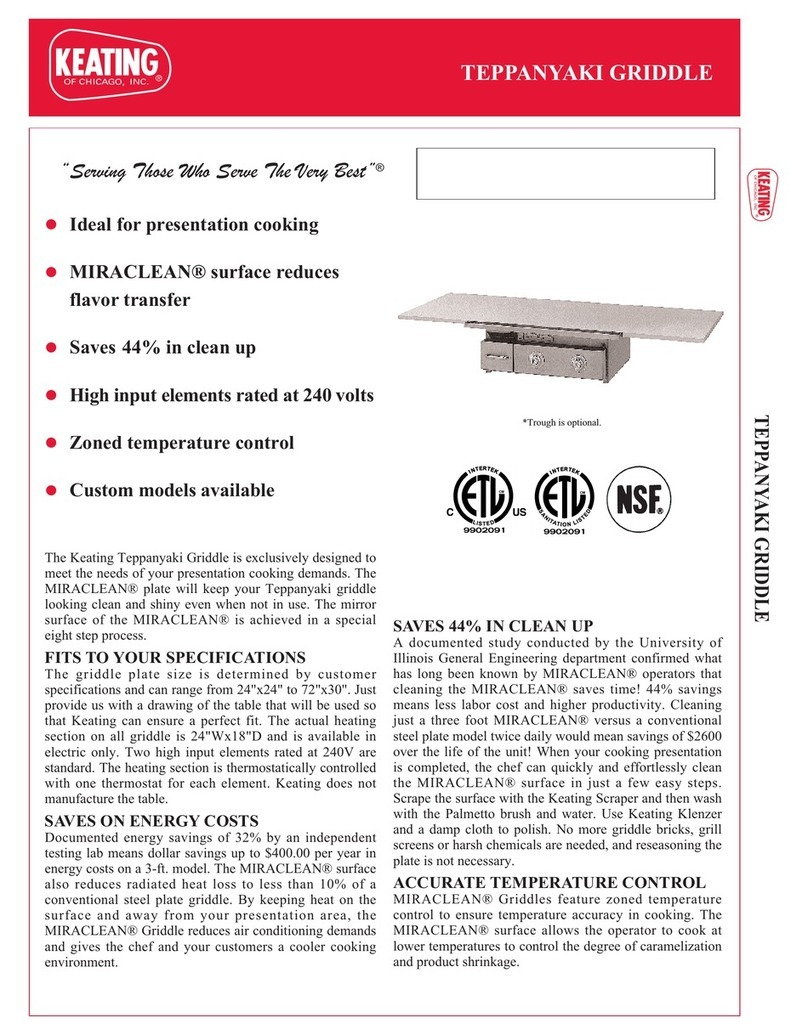
Keating Of Chicago
Keating Of Chicago Teppanyaki Griddle Specification sheet
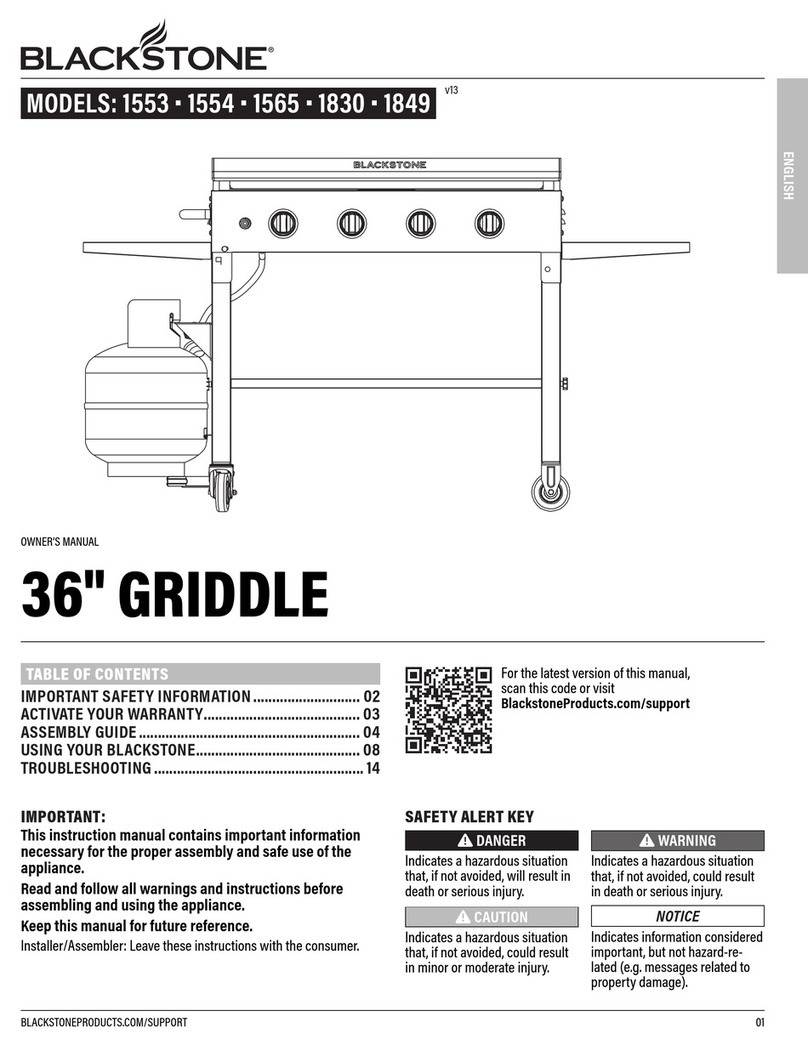
Black Stone
Black Stone 1553 owner's manual
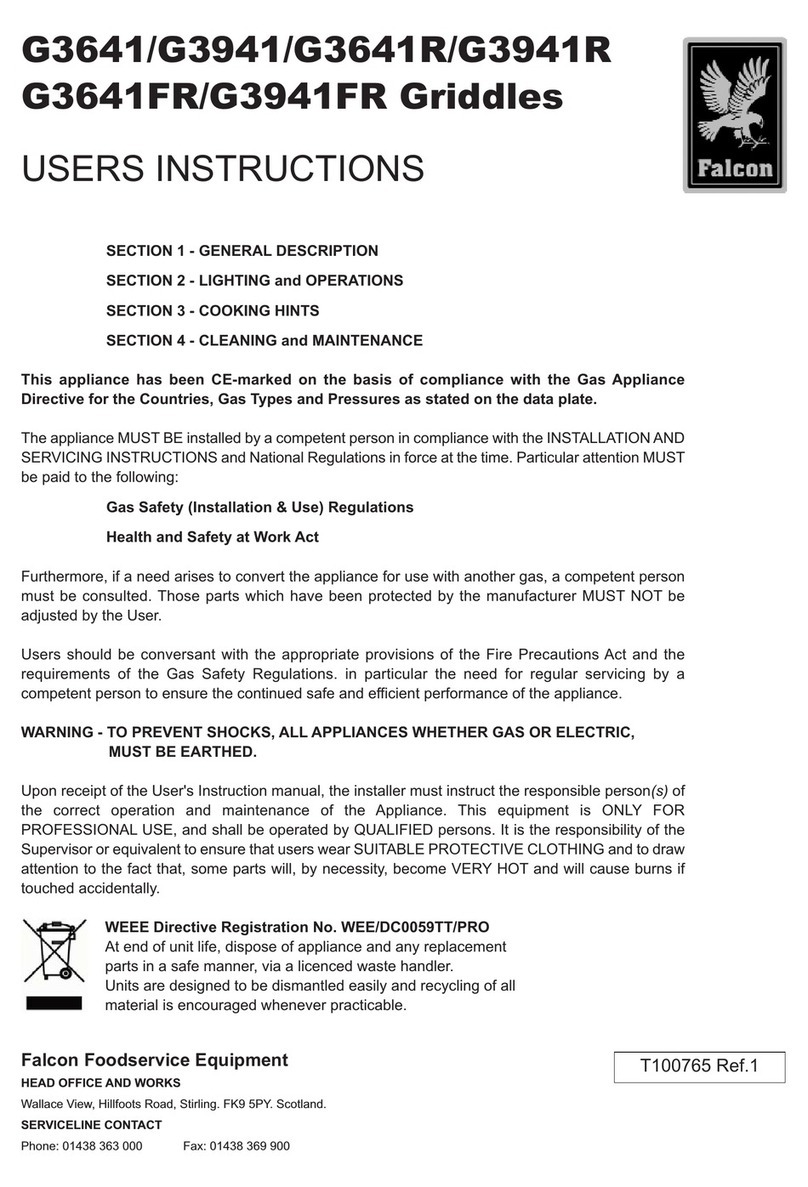
Falcon
Falcon G3641 User instructions
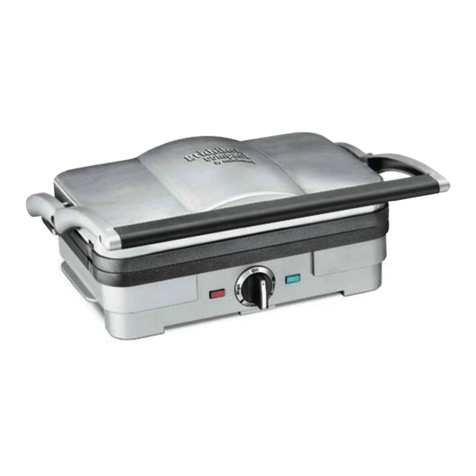
Cuisinart
Cuisinart GR-35 Instruction booklet
